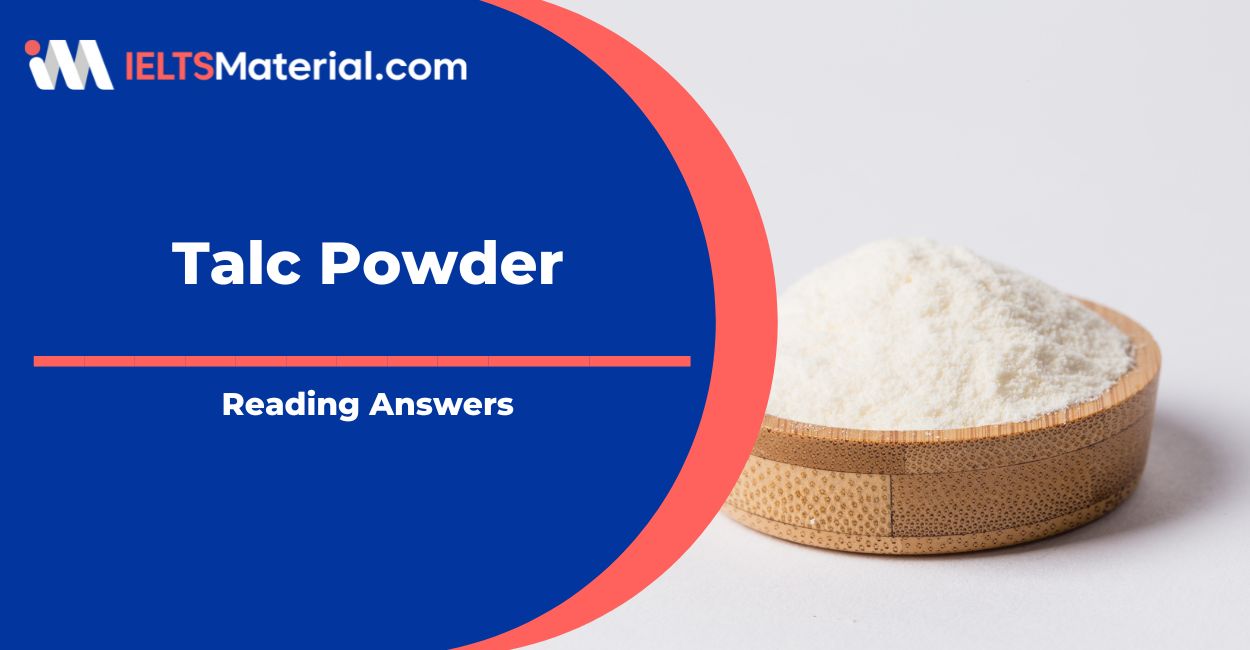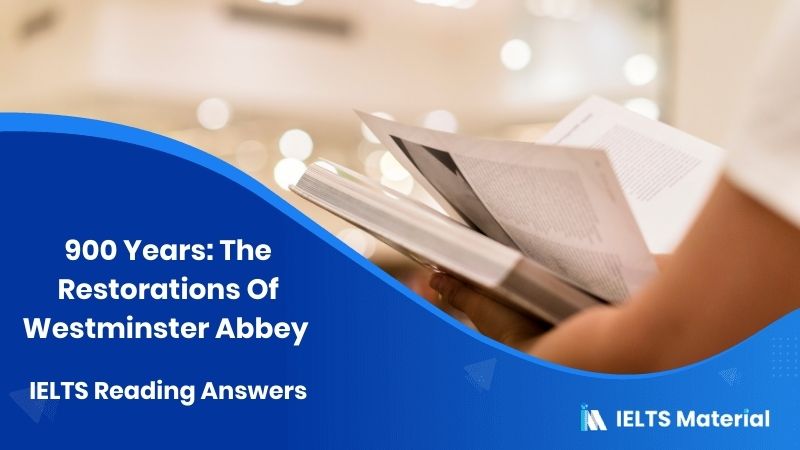Talc Powder Reading Answers
Table of Contents

Limited-Time Offer : Access a FREE 10-Day IELTS Study Plan!
This article contains the Talc Powder reading answers.
Talc Powder is a real Reading test passage that appeared in the IELTS.
With diligent practice, the Reading Module can be the top-scoring category for IELTS Aspirants. To score well, you must understand how to approach and answer the different question types in the Reading Module.
By solving and reviewing Sample Reading Questions from past IELTS papers, you can ensure that your Reading skills are up to the mark. Take the practice test Talc Powder below and try more IELTS reading practice tests from IELTSMaterial.com.
For more Summary Completion Questions practice, take a look at IELTS Reading Summary Completion Topic 1 !
Talc Powder
You should spend about 20 minutes on Questions 27-40, which are based on the Reading Passage below. Find the practice test with the Talc Powder PDF here.
Answers
| Question Number | Answers | Explanation |
|---|---|---|
| 27 | B | Paragraph D mentions that for the past 20 years, olive oil processors in Spain have been taking advantage of talc’s unique characteristics to help them boost the amount of oil they extract from crushed olives. Olives are easy to recognize because they produce a lot of extra foam during the stirring process, a consequence of an excess of a fine solid that acts as a natural emulsifier. In the first sentence of paragraph E, it is said that if a half and two percent of talc is added during the stirring process, it absorbs the natural emulsifier in the olives. This is how talc prevents foaming during olive oil extraction. Hence, the answer is B (Olive oil extraction). |
| 28 | A | Paragraph C intimates that talc is used in the manufacture of chewing gum as a filler in the gum base. It is also used to dust the gum base pellets and to stop the chewing gum sticking during the lamination and packing process. Hence, the answer is A (Chewing gum manufacture). |
| 29 | B | Paragraph D points out that for the past 20 years or so, olive oil processors in Spain have been taking advantage of talc’s unique characteristics to help them boost the amount of oil they extract from crushed olives, that is, it boosts production. Hence, the answer is B (Olive oil extraction). |
| 30 | A | Paragraph C discusses that talc is used in the manufacture of chewing gum as a filler in the gum base. It makes an ideal filler because it’s non-reactive chemically. Hence, the answer is A (Chewing gum manufacture). |
| 31 | C | Paragraph F states that fruit can get sunburned. In fact, in very sunny regions up to 45 percent of a typical crop can be affected by heat stress and sunburn. Later, in paragraph G, Greg Hunter, a marketing specialist, is quoted saying that it was their idea to coat the fruit with talc to protect it from the sun. So, it can be concluded that talc is used to protect fruit crops from sunburn and other damages from the sun. Hence, the answer is C (Fruit crop protection). |
| 32 | B | Paragraph E informs that if a half and two percent of talc is added by weight during the stirring process, it absorbs the natural emulsifier in the olives and so boosts the amount of oil you can extract. In addition, talc’s flat, ‘platy’ structure helps increase the size of the oil droplets liberated during stirring, which again improves the yield. So, talc is used to help increase the size of the product in the olive oil extraction process. Hence, the answer is B (Olive oil extraction). |
| 33 | 20 | Paragraph D reveals that for the past 20 years or so, olive oil processors in Spain have been taking advantage (using) of talc’s unique characteristics to help them boost the amount of oil they extract from crushed olives (olive oil industry). Hence, the answer is ‘20’. |
| 34 | foam/ extra foam | Paragraph D indicates that “Difficult” olives are those that are more reluctant than the norm to yield up their full oil content. These olives, that is, the ‘difficult’ olives are easy to recognize because they produce a lot of extra foam during the stirring process, a consequence (due to) of an excess of a fine solid (high content of solid matter) that acts as a natural emulsifier. Hence, the answer is ‘foam/extra foam’. |
| 35 | Wastewater | Paragraph D refers to the fact that if the waste water is disposed of directly into local fields, often the case in many smaller processing operations (traditional method of oil extraction used in some smaller plants), the emulsified oil may take some time to biodegrade. So, it can be concluded that the traditional method of oil extraction used in some smaller plants often produces wastewater that contains emulsified oil. Hence, the answer is ‘wastewater’. |
| 36 | harmful | Paragraph D specifies that if the waste water is disposed of directly into local fields – often the case in many smaller processing operations – the emulsified oil (contained in the wastewater) may take some time to biodegrade and so be harmful to the environment. Hence, the answer is ‘harmful’. |
| 37 | biodegrade | Paragraph D communicates that if the waste water is disposed of directly into local fields—often the case in many smaller processing operations—the emulsified oil may take some time to biodegrade and so be harmful to the environment. Hence, the answer is ‘biodegrade’. |
| 38 | droplets | Paragraph E reveals that the talc, during the stirring process, absorbs the natural emulsifier in the olives and so boosts the amount of oil you can extract (increase the production). So, talc’s flat, ‘platy’ structure helps increase the size of the oil droplets (because the size of oil droplets grows) liberated during stirring, which again improves the yield. Hence, the answer is ‘droplets’. |
| 39 | lamination and packing | In the last sentence of paragraph C, it is given that in the factory, talc is also used to dust the gum base pellets and to stop the chewing gum sticking during the lamination and packing process, which are the last two stages of the chewing gum manufacturing process. Hence, the answer is ‘lamination and packing’. |
| 40 | Grape growers | Paragraph H considers that Invelop Maximum SPF, is in its second commercial year on the US market. It is believed that grape growers represent another sector, besides apple farmers, with long term potential and so Invelop intends to target them next. Hence, the answer is ‘grape growers’. |
Check More IELTS Reading Answers
Also check :
Practice IELTS Reading based on question types

Start Preparing for IELTS: Get Your 10-Day Study Plan Today!
Explore other Reading Topics

Janice Thompson

Janice Thompson
Recent Articles

Kasturika Samanta

Kasturika Samanta

Janice Thompson







Post your Comments